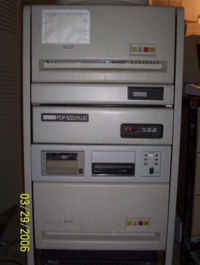PDP-11
From Computer History Wiki
The PDP-11 is a series of computers introduced in 1970 by Digital Equipment Corporation (DEC).
The machine word size was 16 bits. For more information about the architecture itself, see PDP-11 architecture.
It could run a variety of operating systems. Many were produced by DEC themselves, but several were produced by third-parties. Often DEC would purchase or rebrand this OS and resell it as their own product. For example, UNIX sold as Ultrix by DEC.
PDP-11 Models and notes
| Model | Introduced | Bus Type | Addressing | Notes |
|---|---|---|---|---|
| 11/20 | 1970 | UNIBUS | 16-bit | |
| 11/05 | 1972 | UNIBUS | 16-bit | |
| 11/10 | 1972 | UNIBUS | 16-bit | |
| 11/15 | 1972 | UNIBUS | 16-bit | OEM model |
| 11/40 | 1973 | UNIBUS | 18-bit | |
| 11/45 | 1973 | UNIBUS | 18-bit | core memory |
| 11/50 | 1975 | UNIBUS | 18-bit | MOS memory |
| 11/70 | 1975 | UNIBUS | 22-bit | |
| 11/03 | 1975 | QBUS | 16-bit | first QBUS model, first F-11 |
| 11/34 | 1976 | UNIBUS | 18-bit | |
| 11/04 | 1976 | UNIBUS | 16-bit | |
| 11/55 | 1976 | UNIBUS | 18-bit | fast bipolar memory |
| 11/60 | 1977 | UNIBUS | 18-bit | writable control store |
| 11/23 | 1979 | QBUS | 18-bit or 22-bit | |
| 11/24 | 1979 | UNIBUS | 22-bit | first UNIBUS model to use F-11 chip |
| 11/44 | 1979 | UNIBUS | 22-bit | last non-LSI PDP-11 |
| 11/23+ | 1981 Nov | QBUS | 22-bit | |
| 11/73 | 1983 | QBUS | 22-bit | first J-11 machine, 15MHz, integrated FPU, also first PMI PDP-11 |
| 11/53 | 1984 | QBUS | 22-bit | S-box or standard qbus, integrated FPU, 768KiW memory |
| 11/83 | 1988 | QBUS | 22-bit | J-11 at 18MHz, integrated FPU |
| 11/84 | 1988 | UNIBUS | 22-bit | J-11 at 18MHz, integrated FPU |
| 11/93 | 1990 | QBUS | 22-bit | J-11 at 18MHz, integrated FPU, 2MiW onboard memory |
| 11/94 | 1990 | UNIBUS | 22-bit | J-11 at 18MHz, integrated FPU, 2MiW onboard memory |
